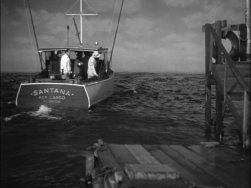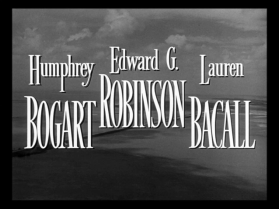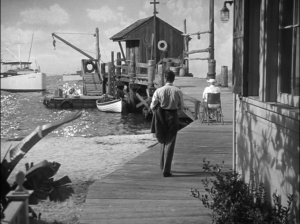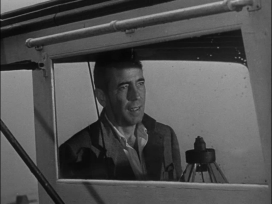When I saw that Silver Screenings and Speakeasy were hosting a Beach Party Blogathon, I immediately wanted to write about the link between setting and sexuality in Some Like It Hot or to wax poetic over my first childhood screening of Beach Blanket Bingo (and how even typing that made me start to sing the theme tune).
But this is a film noir blog (mostly here to announce a weekly live tweet), so none of the above would do. And noir is primarily an urban genre/style, so I had to think hard. I could shove Hitchcock’s Rebecca into the category, with its crashing waves and their thematic implications. Or I could take more obvious fare, such as Renoir’s The Woman on the Beach.


Ultimately, I decided on Key Largo. For one, I wanted to watch it again, and this provided the perfect opportunity. For another, the cast is amazing and the storm brings together setting and narrative wonderfully.
Clare Trevor should be up there!

To be fair, there’s very little beach in the film. We see it mostly in the early scenes, when ex-arrmy captain and wanderer Frank McCloud (Bogart) arrives on the little island of Key Largo in the Florida Keys to pay his respects to the family of George Temple, one of the men he commanded. He is greeted with warmth by the soldier’s wheelchair-bound father James Temple (Lionel Barrymore) and widowed daughter-in-law Nora Temple (Bacall). The outdoor scenes are well lit and cheerful. Though the heat is intense, the white clothing and the sunlight on the sea bring a mood of optimism that will soon shift, via both weather and narrative.
To avoid a lengthy plot summary, I want to stick to the focus on the hurricane and its importance, on the storm that brings the sea across the beach and over the island. The character who thematically brings the storm to Key Largo and the hotel owned by the Temples is Johnny Rocco (Edward G. Robinson), an exiled mobster who is sneaking back into the country via the Keys. The film will show us whether he is truly dangerous — one cell of a criminal storm that is ruining the America that soldiers like George fought and died for — or just another blowhard.
When we meet Rocco, his gang, and his gal, they are already established in the hotel, off-season, posing as a group of Wisconsin fishermen. Their relationship to the island, beach, and ocean is entirely false. They spend no time outdoors, and the closest we see Rocco get to the sea is his bathtub:
By contrast, the people most connected to the island are a small group of Seminoles, the impoverished, disenfranchised remnant of the native population. They fulfill the role of nostalgia for a lost era, even as they are objectified. The natives have come by boat for shelter from the storm, which the Temples are happy to provide in their hotel, explaining how sad it is that the Seminoles have been so dispossessed of their land and identity. (Two younger Seminoles, the Osceola brothers, were put in jail on minor charges, and we are told by James that 30 days for an Indian is like 300 days for anyone else.) Moreover, the camera lingers objectifyingly when Nora introduces Frank to the group’s oldest woman, the postcolonial gaze made plain. To support this reading, we can note that the actress who portrayed the woman, Puerto Rican-born Felipa Gomez, earned no screen credit, nor did any of the other Seminole characters, even those with lines, such as Tom Osceola, played by Jay Silverheels.
 Within the film’s post-war/noir theme of corruption vs. determination, the Seminoles represent innocence, a proud people of the past. Their world cannot be regained, but their love of the land and each other can be…at least by loving white folks like the Temples and those they inspire, including Frank McCourt. When the hurricane strikes, therefore, it is important that Rocco demands the Seminoles — adults and children alike — be shut out in the storm.
Within the film’s post-war/noir theme of corruption vs. determination, the Seminoles represent innocence, a proud people of the past. Their world cannot be regained, but their love of the land and each other can be…at least by loving white folks like the Temples and those they inspire, including Frank McCourt. When the hurricane strikes, therefore, it is important that Rocco demands the Seminoles — adults and children alike — be shut out in the storm.
Rocco condemns the natives and the worldview they represent. He keeps the Temples and McCourt close at hand, however, as they might be swayed to corruption, particularly lovely Nora and morally ambiguous Frank. James, by contrast, displays his loathing of Rocco and what he stands for. Were he not old and disabled and loved by Nora as a father figure, he would no doubt be dead. As the storm builds, so does Rocco’s determination. To get Nora, he kisses her roughly without consent, then whispers words so filthy into Nora’s ear that the audience doesn’t get to hear them.
Needless to say, this doesn’t work, and both hurricane and interpersonal tension mount. Frank is increasingly drawn to Nora and the stability and honesty (not to mention gorgeousness) she represents; Rocco’s girlfriend from the past, Gaye Dawn (Claire Trevor), drowns her knowledge of the truth about her man and her misspent life in alcohol; and Rocco, like the ocean, grows increasingly wild and out of control.
As the storm comes to an end, the film does not. Rocco has killed a local police officer and blamed it on the Osceola brothers, whom the sheriff then kills. Is justice impossible, or just postponed in the chaos of the literal and symbolic hurricane of the immediate post-war era?
This is Bogart’s film, in the end, and his character will determine how we feel at film’s end. The possibility of an idyllic life may be long gone (and was always a myth, even if the film seems to argue otherwise via the Seminole), but the battle for decency and hope for the future is not. So, Frank agrees to set sail with Rocco and his thugs and get them safely to Cuba with their loot. It is on the ocean Frank will decide where he belongs, and why.

With each hoodlum he vanquishes, Frank moves further from cynicism and isolation. The drawn-out sequence in which Rocco, now alone and hidden behind a door below deck, tries to convince Frank to put down his gun is riveting. Frank has seen Rocco’s tricks, and falls for none of them. Moreover, he must reject each possible step toward corruption. The final step must be Rocco’s murder, for he is a symbol of greed and ruthlessness America cannot afford. Only then can Frank turn the ship around and head for the beach of beautiful Key Largo once more, to Nora and the indefatigable American dream.
– – –
This post is a contribution to the








June 8, 2015 at 5:41 PM
Great job!
LikeLiked by 1 person
June 8, 2015 at 7:48 PM
Thanks! I enjoyed thinking my argument through and writing it.
LikeLiked by 1 person
June 8, 2015 at 9:28 PM
That Eddie G. was a nasty sucker in this one, for sure! Nice write-up!
LikeLike
June 9, 2015 at 2:47 PM
I agree, and I just love his acting chops. Thanks for reading!
LikeLike
June 8, 2015 at 10:33 PM
Yes, I love how the tension and the storm both increase in pressure. I like how you put that in your insightful post. You’ve done justice to this film (one of my faves).
Thanks for bringing Bogart and Bacall to the Beach Party blogathon!
LikeLike
June 9, 2015 at 1:40 AM
Although “Key Largo” may have been “Bogart’s film,” I thought that Director Huston showed much more interest in the devolopment of the characters of Ricco, ( Edward G. Robinson) and his aging, alcholic and tragic moll, Gaye Dawn, ( Claire Trevor), and it shows in the film. Claire Trevor was awarded “Best Supporting Actress Award” for this film, although Robinson was ignored. That is not to say that Bogart and Bacall in their final film together did not impress. Thanks for the interesting review.
LikeLiked by 1 person
June 9, 2015 at 2:20 AM
I agree entirely and I adore Claire Trevor. For the focus on the American post-war dream and the locale/storm, I believe we look to Bogart’s character for the film’s ultimate message. I certainly don’t believe it’s “his film” as an actor.
LikeLike
June 9, 2015 at 1:50 AM
Very interesting summary of the movie. I like how you compared the storm to the tensions between the people. Great how you explain what the seminole people represent as well. It sounds like a good one. I would love to see it!
LikeLiked by 1 person
June 9, 2015 at 2:19 AM
Thanks for reading and so glad you enjoyed the post. It’s definitely a classic.
LikeLike
June 9, 2015 at 5:53 AM
Great piece! So much building of tension in this film- love it! And the performances really shine from this star-studded cast.
LikeLiked by 1 person
June 9, 2015 at 2:33 PM
Thanks for reading. I think I like the film more after writing about it!
LikeLike
June 9, 2015 at 6:13 AM
Great post – this is one of the few Bogie films I haven’t seen so I enjoyed reading your thoughts on it. Films set by the ocean always seem to have a certain energy, this one sounds no different!
LikeLiked by 1 person
June 9, 2015 at 2:32 PM
Thanks for reading. It’s definitely worth seeing.
LikeLike
June 9, 2015 at 2:36 PM
Beautiful review. I’ve wanted to watch Key Largo for a long time now, But never got a chance to do so. Now am even more keen.
LikeLiked by 1 person
June 9, 2015 at 2:42 PM
Thanks so much. It’s definitely worth watching!
LikeLike
June 10, 2015 at 5:04 AM
Great review! This is one of my favorite movies. Your comparison of Edward G. Robinson to the hurricane is very apt. He is just such a force of nature in this movie — His energy almost comes right through the screen
LikeLiked by 1 person
June 10, 2015 at 4:48 PM
Thanks! I agree entirely. Frankly, I’ve never seen Edward G. be less than magnetic!
LikeLike
June 10, 2015 at 2:56 PM
Good pick for the event since the seafaring and the storm are so important to the story and feel. As good as all the work in this movie is like the comments above, I really love Robinson and Trevor here. Thanks for taking part!
LikeLiked by 1 person
June 10, 2015 at 4:48 PM
I love Robinson and Trevor, too. Trevor is less central to this theme, but not to the film! Thanks for reading, and for the praise!
LikeLike
June 11, 2015 at 8:01 PM
Great review – I was interested in your thoughts about the native American characters and will bear this and your other points in mind when revisiting this film. Must agree that the whole cast is excellent, in particular Robinson and Trevor.
LikeLiked by 1 person
June 11, 2015 at 10:46 PM
Thanks so much for your kind words. Glad you enjoyed the post!
LikeLike
June 15, 2015 at 3:29 AM
After I watched this film it made me really want to go to Key Large. The boat from the African Queen is down there too! Great write-up! Interesting (and sad) about the Seminoles…
LikeLiked by 1 person
June 15, 2015 at 3:30 AM
Thanks for reading. I’d love to go to the Keys and enjoy the Bogart film festival, too!
LikeLike
June 20, 2015 at 9:14 PM
What an excellent read. Really appreciate the effort you put into this post. I’m not a huge Bogey fan, but do really enjoy Key Largo. E. G. Robinson is amazing, here along with Bacall. It has been a while since I’ve seen it and I’m kicking myself for not making the same connection you did between the storm and the Seminoles. Need to rewatch this.
LikeLiked by 1 person
June 20, 2015 at 9:16 PM
Many thanks for the kind words and for reading. I do love film analysis and (over)read whenever possible!
LikeLike